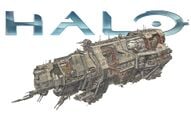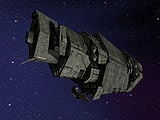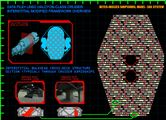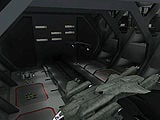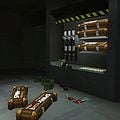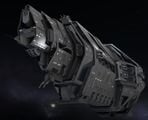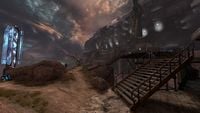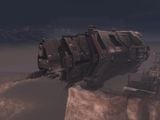Halcyon-class light cruiser: Difference between revisions
From Halopedia, the Halo wiki
m (Just migrating over the new infobox. I will be rewriting the page later.) |
(Overhauled the page, separated the stuff about the Pillar of Autumn's refits into its own section. Also, someone should cite the source where it's claimed that the Roman Blue had honeycomb hull construction.) |
||
| Line 15: | Line 15: | ||
}} | }} | ||
|hide-characteristics= | |hide-characteristics= | ||
|nocollapse = | |nocollapse = Yes | ||
|type = [[Cruiser]] | |type = [[Cruiser]] | ||
|length = {{Convert|3840.64|ft|m|sp=us|sigfig=6|disp=flip}}<ref name="H1GameData">'''Halo: Combat Evolved''' 3D model data</ref>{{Ref/Reuse|Enc22}} | |length = {{Convert|3840.64|ft|m|sp=us|sigfig=6|disp=flip}}<ref name="H1GameData">'''Halo: Combat Evolved''' 3D model data</ref>{{Ref/Reuse|Enc22}} | ||
| Line 46: | Line 46: | ||
{{Quote|A dozen [[Covenant]] superior battleships against a single Halcyon-class cruiser. Given those odds, I'm content with three...make that four kills.|[[Cortana]] during the [[Battle of Installation 04]].<ref name="TPOA">'''[[Halo: Combat Evolved]]''', campaign level ''[[The Pillar of Autumn (Halo: Combat Evolved level)|The Pillar of Autumn]]''</ref>}} | {{Quote|A dozen [[Covenant]] superior battleships against a single Halcyon-class cruiser. Given those odds, I'm content with three...make that four kills.|[[Cortana]] during the [[Battle of Installation 04]].<ref name="TPOA">'''[[Halo: Combat Evolved]]''', campaign level ''[[The Pillar of Autumn (Halo: Combat Evolved level)|The Pillar of Autumn]]''</ref>}} | ||
The '''''Halcyon''-class light cruiser''',{{Ref/Reuse|Enc22}} known as the '''Human Attack Ship class C-II''' by the [[Covenant]],{{Ref/Book|Id=TF|TF|Chapter=Prologue}} is a [[United Nations Space Command]] cruiser starship classification designed by [[Robert McLees (ship designer)|Dr. Robert McLees]] before [[2507]], with a [[hull classification symbol]] of '''C'''. | The '''''Halcyon''-class light cruiser''',{{Ref/Reuse|Enc22}} known as the '''Human Attack Ship class C-II''' by the [[Covenant]],{{Ref/Book|Id=TF|TF|Chapter=Prologue}} is a [[United Nations Space Command]] cruiser starship classification designed by [[Robert McLees (ship designer)|Dr. Robert McLees]] before [[2507]], with a [[hull classification symbol]] of '''C'''. Originally designed for attack and defense role in mind,{{Ref/Book|Id=EVG|EVG|Chapter=Cruiser|Page=42}} they were also capable of being used as troop and supply transports.{{Ref/Reuse|Enc11}} | ||
Their service lives were short due to a unique hull design that was costly to construct and maintain with low maneuverability, poor armament, and concerns about their tactical viability. They were replaced by the {{Class|Marathon|cruiser}}. Despite the disadvantages of the original design, the heavily modified {{UNSCShip|Pillar of Autumn}} proved to be one of the most effective, and costly, ships deployed in the war. | Their service lives were short due to a unique hull design that was costly to construct and maintain with low maneuverability, poor armament, and concerns about their tactical viability. They were replaced by the {{Class|Marathon|cruiser}}. Despite the disadvantages of the original design, the heavily modified {{UNSCShip|Pillar of Autumn}} proved to be one of the most effective, and costly, ships deployed in the war. After the Human-Covenant War, surviving ''Halcyon''-class hulls were recycled to form the basis of the {{Class|Autumn|heavy cruiser|heavy cruisers}}. | ||
== | ==Overview== | ||
=== | ===Design details=== | ||
''Halcyon''-class | Maintaining the monolithic hull design of other UNSC cruisers, the ''Halcyon''-class were visually distinguished by their composition of five hexagonal and octagonal hull sections, each of which stacked on top of each other and progressively grew as they ran towards the engines. The frontmost surface of these cruisers was dominated by a long antenna structure called the foremast, whose base sat below the muzzle of the MAC. The [[bridge]] was slung underneath the front section on a portruding structure, which made it very vulnerable to enemy fire. The second-last hull section possessed four [[hangar bay|docking bay]]s that ran down either side like an equatorial line, and the keel featured a drop bay capable of deploying both [[SOEIV]] and dropships. Personnel made use of lifts, stairs, and mag-rail platforms for quick transit around the cruiser.{{Ref/Reuse|WFPoA}} To evacuate personnel during emergencies, these cruisers had at least 18 [[Class-3 Bumblebee]]s. | ||
The | The aftmost section was largely devoted to the cruiser's propulsion and powerplant systems, which as originally installed were three [[Mark II Hanley-Messer DFR]]s.{{Ref/Reuse|data drop}} Designed for bulk manoeuvring rather than speed,<ref>'''[[Halo Mythos]]''', ''page 94''</ref> they were woefully obsolete by 2552, only capable of providing a tenth the output of more modern systems.<ref name="FoRC25">'''Halo: The Fall of Reach''', Chapter 25</ref> They were complemented by four compact auxiliary fusion rockets mounted in pairs, which could provide high thrust but were dogged by inefficiency.{{Ref/Reuse|WFPoA}} Combined, they gave the ''Halcyon''-class a profound lack of speed, and coupled with their minimal firepower they were ineffective in combat.{{Ref/Reuse|FoRC25}} | ||
The most curious element of the ''Halcyon''-class was their unusual frame construction. Designed by [[Robert McLees (ship designer)|Doctor Robert McLees]], they made use of a series of internal cross bracings and [[Titanium-A armor|Titanium-A]]{{Ref/Reuse|FoRC29}} honeycombs. This feature gave the class a reputation for enduring serious punishment, despite their usage of older, heavier armor that provided less protection than modern standards. ''Halcyon''-class cruisers were known to remain operational despite suffering breaches to all compartments and losing 90% of their armor. However, such a scheme was costly and grossly overmassed compared to more conventional measures, which led to it being dropped after the first eleven cruisers.<ref name="FoRC25">'''Halo: The Fall of Reach''', Chapter 25</ref> Aiding in this, corridors aboard the ''Halcyon''-class possessed retractable containment bulkheads which could seal off breached or overrun sections of the ship.<ref name="maw">'''[[Halo: Combat Evolved]]''', campaign level ''[[The Maw]]''</ref> During emergencies, the environmental systems could vent each section to asphyxiate the occupants within.{{Ref/Book|Id=TFC1|TF|Chapter=1}} The ship was pocketed with numerous maintenance and service corridors that ran the length of the ship. If necessary, these expansive corridors, including a [[Class Seven service corridor]] running along the dorsal structure of the vessel, could permit passage to [[Warthog]]s and some sections were large enough to accept [[Pelican]]s.{{Ref/Reuse|maw}} | |||
There were two distinct visual varieties of ''Halcyon''-class cruisers: the earliest version of the cruiser had a rather smooth and flat construction,{{Ref/Reuse|TPOA}} while later portrayals incorporated cut-out portions and often featured [[Spitfire naval coilgun battery#Mark 33 Spitfire|Mark 33 Spitfire naval coilgun battery]]. | |||
''Halcyon''-class cruisers were constructed in space and are not rated for atmospheric deployment | ''Halcyon''-class cruisers were constructed in space and are not rated for atmospheric deployment.{{Ref/Reuse|TFC1}} If necessary, detachable [[R7 thrust coupling]]s could provide them with limited atmospheric flight.<ref name="ReferenceA">'''Halo: Reach''', campaign level ''[[The Pillar of Autumn (Halo: Reach level)|The Pillar of Autumn]]''</ref> | ||
=== | ===Armament=== | ||
The ''Halcyon''-class was by far the most lightly-armed of the UNSC's cruiser classes, being armed with only one [[Magnetic Accelerator Cannon]], 1,800 [[Archer missile]]s, and four [[Shiva-class nuclear missile]]s.{{Ref/Reuse|Enc11}} | |||
An alternative armament scheme provided the ''Halcyon''-class with a single Mark II 56A2D4 light MAC as its primary weapon. This was bolstered with twenty [[M58 Archer missile]] pods, which was far below standards at the time. The class' firepower was further supplemented with four [[Spitfire naval coilgun battery#Mark 33 Spitfire|Mark 33 Spitfire naval coilgun batteries]] and four [[M66 Sentry autocannon]]s, with both types of turrets featuring two barrels each. The ''Halcyon''-class cruisers could also be equipped with forty point defense guns, using either the [[M810 Helix point defense gun|M810 Helix]] or the [[Rampart point defense gun#M910 Rampart|M910 Rampart]] point defense guns.{{Ref/Reuse|Enc22}} | |||
===Refits=== | |||
{{Main|UNSC Pillar of Autumn#Design details}} | |||
Although considered subpar ships, the pressure of the Human-Covenant War forced the UNSC to recommission and refit ''Halcyon''-class cruisers back into service. Generally, they received token armament upgrades through the installation of a MAC and an additional six Archer missile pods.{{Ref/Reuse|FoRC25}} However, when called upon substantially greater changes were authorised. | |||
By far the most expansive and famous of these were the alterations the UNSC ''Pillar of Autumn'' received as part of preparations for Operation: RED FLAG. Selected due to its possession of the honeycomb framing scheme, the refit took advantage of the need to replace its hull plating with reformulated [[Titanium-A armor]], which reduced its mass but also freed up internal volume. Much of this would be taken up by hangars and [[SOEIV]] launch bays, although the former required the removal of long-term accommodations.{{Ref/Reuse|Enc22}} Power was improved with an experimental reactor setup that could not only increase output by up to 300% for short periods of time, but made use of a very efficient laser-induced ion cooling system. Armament was finally expanded, with a MAC capable of firing three times on the same charge,{{Ref/Book|Id=FoRC29|FoR|Chapter=29}} 32 M58 Archer missile pods, 8 Mark 33 Spitfire naval coilgun batteries, and six M66 Sentry autocannons. 18 M910 Rampart point defense guns with overlapping fields of fire provided the final layer of protection against missiles and incoming munitions.{{Ref/Book|Id=WFPoA|WF|Chapter=Human, Pillar of Autumn|Page=24-25}} | |||
==Service history== | ==Service history== | ||
At just over 1.17 kilometers in length, the ''Halcyon''s were the lightest of vessels to be designated and structured as cruisers. Compared to later capital ships, the original ''Halcyon''s were sorely underpowered and undergunned: their Mark II fusion engines provided but a tenth of the output of modern reactors and their armament consisted of a mere six [[Archer missile]] pods and a single [[Magnetic Accelerator Cannon|MAC]] gun. According to the AI [[Cortana]], these ships were considered subpar within the [[UNSC fleet]] by 2552.{{Ref/Reuse| | At just over 1.17 kilometers in length, the ''Halcyon''s were the lightest of vessels to be designated and structured as cruisers. Compared to later capital ships, the original ''Halcyon''s were sorely underpowered and undergunned: their Mark II fusion engines provided but a tenth of the output of modern reactors and their armament consisted of a mere six [[Archer missile]] pods and a single [[Magnetic Accelerator Cannon|MAC]] gun. According to the AI [[Cortana]], these ships were considered subpar within the [[UNSC fleet]] by 2552.{{Ref/Reuse|FoRC25}} Many of these cruisers were retired and placed into long-term storage near [[Europa]] after only a few years of service.{{Ref/Reuse|Enc22}} | ||
When the [[Human-Covenant War]] erupted in [[2525]] a number of ''Halcyon'' cruisers were reactivated from storage and refitted. With the right upgrades, a ''Halcyon''-class cruiser could be a formidable foe. During the [[Battle for Arcadia]] in [[2531]], the {{UNSCShip|Pillar of Autumn}} teamed up with three other ships to destroy [[CCS-U321|a]] {{Pattern|Ket|battlecruiser}}, suffering heavy damage but remaining combat ready enough to provide ground support for the {{UNSCShip|Spirit of Fire}} | When the [[Human-Covenant War]] erupted in [[2525]] a number of ''Halcyon'' cruisers were reactivated from storage and refitted. With the right upgrades, a ''Halcyon''-class cruiser could be a formidable foe. During the [[Battle for Arcadia]] in [[2531]], the {{UNSCShip|Pillar of Autumn}} teamed up with three other ships to destroy [[CCS-U321|a]] {{Pattern|Ket|battlecruiser}}, suffering heavy damage but remaining combat ready enough to provide ground support for the {{UNSCShip|Spirit of Fire}}. Later, during the [[Fall of Reach]], the upgraded ''Pillar of Autumn'' was able to inflict damage far beyond its tonnage, engaging and destroying [[Covenant frigate]]s, a {{Pattern|Ruma|light carrier}} and a [[Kewu-pattern battleship|powerful warship]] of unspecified class. Later, in orbit above the Forerunner construct known as [[Installation 04|Halo]], the ''Autumn'' destroyed four additional ''Ket''-pattern battlecruisers under the guidance of the AI Cortana. While much of this success was due to the tactical genius of Captain Jacob Keyes and his crew, the upgraded ''Autumn'' was highly resilient and capable of unleashing tremendous artillery barrages. | ||
The ship's main Magnetic Accelerator Cannon was enhanced to fire in three-round bursts. While each individual round was weakened, this firing pattern typically ensured at least one projectile would penetrate a Covenant vessel's shields. Damaged, the targeted ship could then be overwhelmed with Archer missiles, nuclear weaponry, or further bombardment once the ''Autumn'' recharged its main batteries. Unfortunately, the ship and nearly all of its original crew were destroyed in an attempt to prevent the firing of the Halo ring, and to prevent the release of the parasitic life-form known as the [[Flood]]. The detonation of the ''Autumn's'' fusion reactors destroyed not only the ring, but the majority of the [[Fleet of Particular Justice|Covenant fleet]] which had pursued it from Reach. | The ship's main Magnetic Accelerator Cannon was enhanced to fire in three-round bursts. While each individual round was weakened, this firing pattern typically ensured at least one projectile would penetrate a Covenant vessel's shields. Damaged, the targeted ship could then be overwhelmed with Archer missiles, nuclear weaponry, or further bombardment once the ''Autumn'' recharged its main batteries. Unfortunately, the ship and nearly all of its original crew were destroyed in an attempt to prevent the firing of the Halo ring, and to prevent the release of the parasitic life-form known as the [[Flood]]. The detonation of the ''Autumn's'' fusion reactors destroyed not only the ring, but the majority of the [[Fleet of Particular Justice|Covenant fleet]] which had pursued it from Reach. | ||
| Line 86: | Line 83: | ||
==Ships of the line== | ==Ships of the line== | ||
Out of 50 Halcyon-class light cruisers built, the first 11 have the honeycomb superstructure while the other 39 have an unspecified | Out of 50 Halcyon-class light cruisers built, the first 11 have the honeycomb superstructure while the other 39 have an unspecified construction.{{Ref/Reuse|HCESGuide}} | ||
===Honeycomb superstructure=== | ===Honeycomb superstructure=== | ||
This is the list of Halcyon-class light cruisers with the honeycomb superstructure: | This is the list of Halcyon-class light cruisers with the honeycomb superstructure: | ||
*{{UNSCShip|Halcyon}} - The [[Wikipedia:lead ship|lead ship]] of the class. | *{{UNSCShip|Halcyon}} - The [[Wikipedia:lead ship|lead ship]] of the class. | ||
*{{UNSCShip|Pillar of Autumn}} (C-709) - Participated in the [[Battle for Arcadia]] in [[2531]], destroying [[CCS-U321|a]] [[Ket-pattern battlecruiser|Covenant battlecruiser]] alongside three other human ships and providing ground support for the {{UNSCShip|Spirit of Fire}}. After refitting in [[2552]], the ''Autumn'', captained by [[Jacob Keyes]], was selected as the [[SPARTAN-II]]s' chariot for [[Operation: RED FLAG]], due to its new resilience and firepower. Destroyed by [[John-117]] in the [[Battle of Installation 04]] through wildcat destabilization of the engines, as a means to destroy [[Halo Array|Halo]] [[Installation 04]]. | *{{UNSCShip|Pillar of Autumn}} (C-709) - Participated in the [[Battle for Arcadia]] in [[2531]], destroying [[CCS-U321|a]] [[Ket-pattern battlecruiser|Covenant battlecruiser]] alongside three other human ships and providing ground support for the {{UNSCShip|Spirit of Fire}}. After refitting in [[2552]], the ''Autumn'', captained by [[Jacob Keyes]], was selected as the [[SPARTAN-II]]s' chariot for [[Operation: RED FLAG]], due to its new resilience and firepower. Destroyed by [[John-117]] in the [[Battle of Installation 04]] through wildcat destabilization of the engines, as a means to destroy [[Halo Array|Halo]] [[Installation 04]]. | ||
===Unknown superstructure=== | ===Unknown superstructure=== | ||
| Line 98: | Line 95: | ||
*{{UNSCShip|Dawn Under Heaven}} | *{{UNSCShip|Dawn Under Heaven}} | ||
*{{UNSCShip|Persian Gate}} - Participated in the [[Battle of Alpha Corvi II]] in [[2526]]. | *{{UNSCShip|Persian Gate}} - Participated in the [[Battle of Alpha Corvi II]] in [[2526]]. | ||
*{{UNSCShip|Roman Blue}} - The first ship to be captained by [[Terrence Hood]]; participated in the [[Battle for Arcadia]].<ref>'''[[Halo: Escalation]]''', ''Issue #5''</ref> Shot down in battle between [[2535]] and [[2552]] and crashed on [[Eiro]]. Wreckage later salvaged by the ''[[Ace of Spades]]'' before an unknown vessel, possibly belonging to ONI, glassed ''Roman Blue's'' remains.<ref>'''[[Halo: Smoke and Shadow]]'''</ref> | |||
*{{UNSCShip|Toulouse}} - Participated in an engagement over an unidentified [[Forerunner]] installation with a Covenant fleet. | *{{UNSCShip|Toulouse}} - Participated in an engagement over an unidentified [[Forerunner]] installation with a Covenant fleet. | ||
Revision as of 02:52, May 5, 2024
| Halcyon-class light cruiser | |||||||||||||||||||||||
|---|---|---|---|---|---|---|---|---|---|---|---|---|---|---|---|---|---|---|---|---|---|---|---|
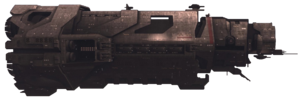
| |||||||||||||||||||||||
| Class attributes | |||||||||||||||||||||||
|
Identification: |
|||||||||||||||||||||||
|
Operators: |
|||||||||||||||||||||||
|
Manufacturer: |
|||||||||||||||||||||||
|
Naval architect: |
|||||||||||||||||||||||
|
Built: |
50[1] | ||||||||||||||||||||||
|
In service: |
2510[2] - present | ||||||||||||||||||||||
| |||||||||||||||||||||||
- "A dozen Covenant superior battleships against a single Halcyon-class cruiser. Given those odds, I'm content with three...make that four kills."
- — Cortana during the Battle of Installation 04.[6]
The Halcyon-class light cruiser,[2] known as the Human Attack Ship class C-II by the Covenant,[7] is a United Nations Space Command cruiser starship classification designed by Dr. Robert McLees before 2507, with a hull classification symbol of C. Originally designed for attack and defense role in mind,[8] they were also capable of being used as troop and supply transports.[3]
Their service lives were short due to a unique hull design that was costly to construct and maintain with low maneuverability, poor armament, and concerns about their tactical viability. They were replaced by the Marathon-class cruiser. Despite the disadvantages of the original design, the heavily modified UNSC Pillar of Autumn proved to be one of the most effective, and costly, ships deployed in the war. After the Human-Covenant War, surviving Halcyon-class hulls were recycled to form the basis of the Autumn-class heavy cruisers.
Overview
Design details
Maintaining the monolithic hull design of other UNSC cruisers, the Halcyon-class were visually distinguished by their composition of five hexagonal and octagonal hull sections, each of which stacked on top of each other and progressively grew as they ran towards the engines. The frontmost surface of these cruisers was dominated by a long antenna structure called the foremast, whose base sat below the muzzle of the MAC. The bridge was slung underneath the front section on a portruding structure, which made it very vulnerable to enemy fire. The second-last hull section possessed four docking bays that ran down either side like an equatorial line, and the keel featured a drop bay capable of deploying both SOEIV and dropships. Personnel made use of lifts, stairs, and mag-rail platforms for quick transit around the cruiser.[9] To evacuate personnel during emergencies, these cruisers had at least 18 Class-3 Bumblebees.
The aftmost section was largely devoted to the cruiser's propulsion and powerplant systems, which as originally installed were three Mark II Hanley-Messer DFRs.[5] Designed for bulk manoeuvring rather than speed,[10] they were woefully obsolete by 2552, only capable of providing a tenth the output of more modern systems.[11] They were complemented by four compact auxiliary fusion rockets mounted in pairs, which could provide high thrust but were dogged by inefficiency.[9] Combined, they gave the Halcyon-class a profound lack of speed, and coupled with their minimal firepower they were ineffective in combat.[11]
The most curious element of the Halcyon-class was their unusual frame construction. Designed by Doctor Robert McLees, they made use of a series of internal cross bracings and Titanium-A[12] honeycombs. This feature gave the class a reputation for enduring serious punishment, despite their usage of older, heavier armor that provided less protection than modern standards. Halcyon-class cruisers were known to remain operational despite suffering breaches to all compartments and losing 90% of their armor. However, such a scheme was costly and grossly overmassed compared to more conventional measures, which led to it being dropped after the first eleven cruisers.[11] Aiding in this, corridors aboard the Halcyon-class possessed retractable containment bulkheads which could seal off breached or overrun sections of the ship.[13] During emergencies, the environmental systems could vent each section to asphyxiate the occupants within.[14] The ship was pocketed with numerous maintenance and service corridors that ran the length of the ship. If necessary, these expansive corridors, including a Class Seven service corridor running along the dorsal structure of the vessel, could permit passage to Warthogs and some sections were large enough to accept Pelicans.[13]
There were two distinct visual varieties of Halcyon-class cruisers: the earliest version of the cruiser had a rather smooth and flat construction,[6] while later portrayals incorporated cut-out portions and often featured Mark 33 Spitfire naval coilgun battery.
Halcyon-class cruisers were constructed in space and are not rated for atmospheric deployment.[14] If necessary, detachable R7 thrust couplings could provide them with limited atmospheric flight.[15]
Armament
The Halcyon-class was by far the most lightly-armed of the UNSC's cruiser classes, being armed with only one Magnetic Accelerator Cannon, 1,800 Archer missiles, and four Shiva-class nuclear missiles.[3]
An alternative armament scheme provided the Halcyon-class with a single Mark II 56A2D4 light MAC as its primary weapon. This was bolstered with twenty M58 Archer missile pods, which was far below standards at the time. The class' firepower was further supplemented with four Mark 33 Spitfire naval coilgun batteries and four M66 Sentry autocannons, with both types of turrets featuring two barrels each. The Halcyon-class cruisers could also be equipped with forty point defense guns, using either the M810 Helix or the M910 Rampart point defense guns.[2]
Refits
- Main article: UNSC Pillar of Autumn § Design details
Although considered subpar ships, the pressure of the Human-Covenant War forced the UNSC to recommission and refit Halcyon-class cruisers back into service. Generally, they received token armament upgrades through the installation of a MAC and an additional six Archer missile pods.[11] However, when called upon substantially greater changes were authorised.
By far the most expansive and famous of these were the alterations the UNSC Pillar of Autumn received as part of preparations for Operation: RED FLAG. Selected due to its possession of the honeycomb framing scheme, the refit took advantage of the need to replace its hull plating with reformulated Titanium-A armor, which reduced its mass but also freed up internal volume. Much of this would be taken up by hangars and SOEIV launch bays, although the former required the removal of long-term accommodations.[2] Power was improved with an experimental reactor setup that could not only increase output by up to 300% for short periods of time, but made use of a very efficient laser-induced ion cooling system. Armament was finally expanded, with a MAC capable of firing three times on the same charge,[12] 32 M58 Archer missile pods, 8 Mark 33 Spitfire naval coilgun batteries, and six M66 Sentry autocannons. 18 M910 Rampart point defense guns with overlapping fields of fire provided the final layer of protection against missiles and incoming munitions.[9]
Service history
At just over 1.17 kilometers in length, the Halcyons were the lightest of vessels to be designated and structured as cruisers. Compared to later capital ships, the original Halcyons were sorely underpowered and undergunned: their Mark II fusion engines provided but a tenth of the output of modern reactors and their armament consisted of a mere six Archer missile pods and a single MAC gun. According to the AI Cortana, these ships were considered subpar within the UNSC fleet by 2552.[11] Many of these cruisers were retired and placed into long-term storage near Europa after only a few years of service.[2]
When the Human-Covenant War erupted in 2525 a number of Halcyon cruisers were reactivated from storage and refitted. With the right upgrades, a Halcyon-class cruiser could be a formidable foe. During the Battle for Arcadia in 2531, the UNSC Pillar of Autumn teamed up with three other ships to destroy a Ket-pattern battlecruiser, suffering heavy damage but remaining combat ready enough to provide ground support for the UNSC Spirit of Fire. Later, during the Fall of Reach, the upgraded Pillar of Autumn was able to inflict damage far beyond its tonnage, engaging and destroying Covenant frigates, a Ruma-pattern light carrier and a powerful warship of unspecified class. Later, in orbit above the Forerunner construct known as Halo, the Autumn destroyed four additional Ket-pattern battlecruisers under the guidance of the AI Cortana. While much of this success was due to the tactical genius of Captain Jacob Keyes and his crew, the upgraded Autumn was highly resilient and capable of unleashing tremendous artillery barrages.
The ship's main Magnetic Accelerator Cannon was enhanced to fire in three-round bursts. While each individual round was weakened, this firing pattern typically ensured at least one projectile would penetrate a Covenant vessel's shields. Damaged, the targeted ship could then be overwhelmed with Archer missiles, nuclear weaponry, or further bombardment once the Autumn recharged its main batteries. Unfortunately, the ship and nearly all of its original crew were destroyed in an attempt to prevent the firing of the Halo ring, and to prevent the release of the parasitic life-form known as the Flood. The detonation of the Autumn's fusion reactors destroyed not only the ring, but the majority of the Covenant fleet which had pursued it from Reach.
The Autumn-class heavy cruiser, commissioned into service following the end of the Human-Covenant War, is based upon the Halcyon-class cruiser Pillar of Autumn in both superficial design and name.[16]
Ships of the line
Out of 50 Halcyon-class light cruisers built, the first 11 have the honeycomb superstructure while the other 39 have an unspecified construction.[1]
Honeycomb superstructure
This is the list of Halcyon-class light cruisers with the honeycomb superstructure:
- UNSC Halcyon - The lead ship of the class.
- UNSC Pillar of Autumn (C-709) - Participated in the Battle for Arcadia in 2531, destroying a Covenant battlecruiser alongside three other human ships and providing ground support for the UNSC Spirit of Fire. After refitting in 2552, the Autumn, captained by Jacob Keyes, was selected as the SPARTAN-IIs' chariot for Operation: RED FLAG, due to its new resilience and firepower. Destroyed by John-117 in the Battle of Installation 04 through wildcat destabilization of the engines, as a means to destroy Halo Installation 04.
Unknown superstructure
This is a list of Halcyon-class light cruisers that haven't gotten their superstructure confirmed yet:
- UNSC Constantinople - Participated and destroyed during the Second Battle of Harvest in 2526.
- UNSC Dawn Under Heaven
- UNSC Persian Gate - Participated in the Battle of Alpha Corvi II in 2526.
- UNSC Roman Blue - The first ship to be captained by Terrence Hood; participated in the Battle for Arcadia.[17] Shot down in battle between 2535 and 2552 and crashed on Eiro. Wreckage later salvaged by the Ace of Spades before an unknown vessel, possibly belonging to ONI, glassed Roman Blue's remains.[18]
- UNSC Toulouse - Participated in an engagement over an unidentified Forerunner installation with a Covenant fleet.
Trivia

|
Browse more images in this article's gallery page. |
- "Halcyon" is derived from the Greek word "Alcyone", which means "marked by peace and prosperity".
- The scrapped hulls of several Halcyon-class cruisers can be seen in the Halo: Reach campaign level The Pillar of Autumn and the multiplayer map Boneyard.
- The Pillar of Autumn's model from Halo: Reach is considerably larger than its original Halo: Combat Evolved counterpart. Indeed, it is longer than even the Marathon-class cruiser.
- The Pillar of Autumn plays a role in Halo: Combat Evolved, Halo: Reach and Halo Wars. In each game, the ship provides support to the player in some form.
Gallery
An armory
A Halcyon-class using its 50mm PDG against Covenant boarding craft in Halo Legends: Origins.
Halcyon cruisers sitting in a decommissioning yard on Reach.
Another view of a Halcyon class cruiser on Reach.
Halcyon-class cruisers during an unknown battle in Halo: Escalation.
A Halcyon-class light cruiser in Halo 2: Anniversary terminals.
List of appearances
|
|
Sources
- ^ a b c Halo: Combat Evolved: Sybex Official Strategies & Secrets, Chapter The Pillar of Autumn, page 60
- ^ a b c d e f g h i j k l m n Halo Encyclopedia (2022 edition), chapter Human Spaceships, Cruisers, page 119
- ^ a b c d e f g h Halo Encyclopedia (2011 edition), chapter UNSC Ships, page 261
- ^ a b c Halo: Combat Evolved 3D model data
- ^ a b c d Halo Waypoint: Data Drop 5
- ^ a b Halo: Combat Evolved, campaign level The Pillar of Autumn
- ^ TF, chapter Prologue
- ^ Halo: The Essential Visual Guide, chapter Cruiser, page 42
- ^ a b c WF, chapter Human, Pillar of Autumn, page 24-25
- ^ Halo Mythos, page 94
- ^ a b c d e Halo: The Fall of Reach, Chapter 25
- ^ a b FoR, chapter 29
- ^ a b Halo: Combat Evolved, campaign level The Maw
- ^ a b TF, chapter 1
- ^ Halo: Reach, campaign level The Pillar of Autumn
- ^ Halo 4: The Essential Visual Guide
- ^ Halo: Escalation, Issue #5
- ^ Halo: Smoke and Shadow
- ^ Halo Waypoint: Canon Fodder - Taking Orders
| ||||||||||||||||||||||||||||||||||||||||||||||||||||||||
